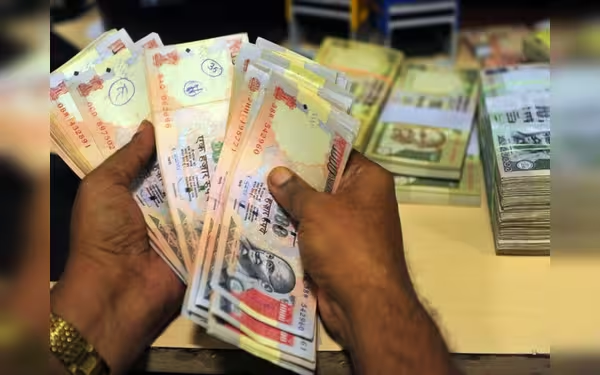Saturday, November 16, 2024 05:58 PM
Indian Rupee Stays Steady at 84/USD Amid Fed Rate Cut Speculations
- Indian rupee hovers near all-time low against USD.
- RBI intervenes to maintain rupee stability at 84 level.
- US jobs report diminishes chances of Fed rate cuts.
 Image Credits: brecorder
Image Credits: brecorderThe Indian rupee remains stable at 84/USD as the RBI intervenes amid changing Fed rate cut expectations.
The Indian rupee has been facing significant pressure in recent times, particularly as it hovers near its all-time low against the US dollar. This situation has been exacerbated by a recent US jobs report that has led investors to reassess the likelihood of the Federal Reserve implementing another substantial rate cut in the near future. As of Monday, the rupee is expected to open at around 83.97-83.98 to the US dollar, a slight change from the previous session's rate of 83.9725, and just shy of its lifetime low of 83.9850 recorded on September 5.
A currency trader noted that a “similar script” is likely to unfold, indicating that the rupee's recent behavior is expected to continue. The trader remarked that the dollar/rupee pair “should have opened way higher,” but attributed the stability of the rupee to the actions of India’s central bank. The Reserve Bank of India (RBI) has been actively defending the 84 level for the past two months, intervening in both the non-deliverable forward and the onshore over-the-counter markets to prevent the rupee from slipping past this critical threshold.
On Friday, the dollar index saw an increase, and US Treasury yields surged following the release of the September US jobs report. This report revealed the largest increase in jobs in six months, a decrease in the unemployment rate, and a rise in wages, showcasing the resilience of the US labor market. According to MUFG Bank, the robust jobs report has shifted the odds regarding the Federal Reserve's potential rate cuts. The chances of a 50 basis point cut at the upcoming November meeting have plummeted to just 6%, down from nearly 50% a week earlier.
Additionally, ongoing tensions in the Middle East have contributed to the strength of the US dollar as a safe-haven currency. MUFG Bank highlighted that with the Middle East conflict showing no signs of resolution, a spike in oil prices could further deteriorate the trade conditions for many Asian economies, thereby exerting renewed downward pressure on their currencies.
The Indian rupee's struggle against the US dollar reflects broader economic trends and geopolitical tensions. As the RBI continues to intervene to stabilize the currency, the future remains uncertain. Investors and analysts alike will be closely monitoring both domestic and international developments, as these factors will undoubtedly influence the rupee's trajectory in the coming weeks. Understanding these dynamics is crucial for anyone looking to navigate the complexities of currency markets effectively.













